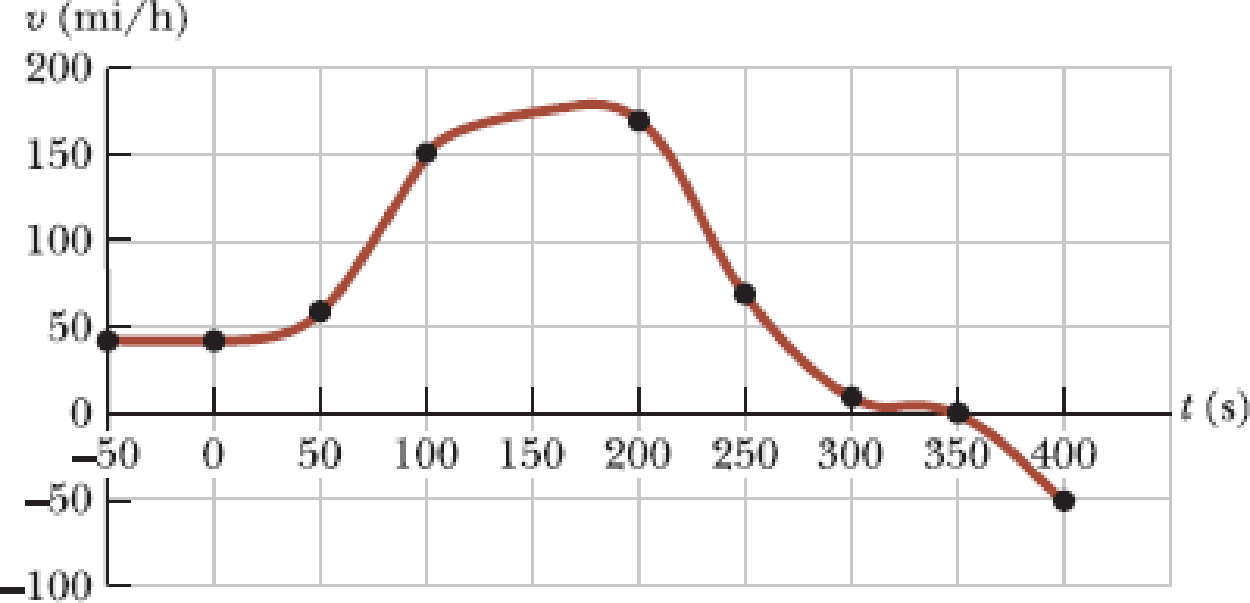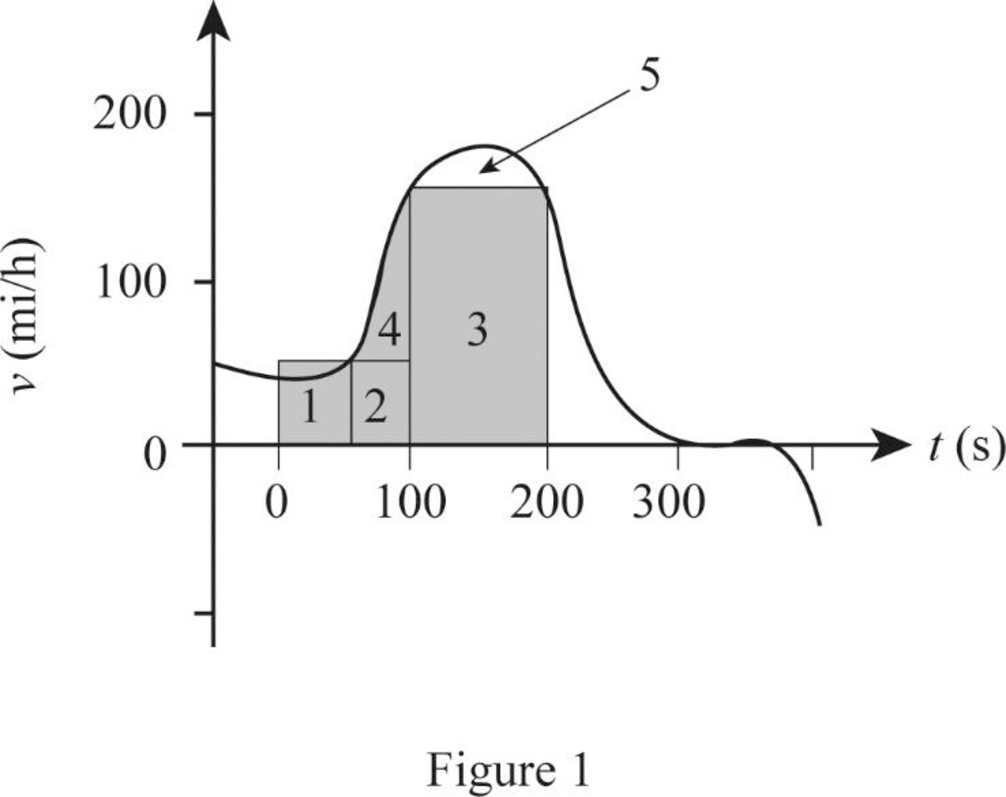
Concept explainers
The Acela is an electric train on the Washington–New York–Boston run, carrying passengers at 170 mi/h. A velocity–time graph for the Acela is shown in Figure P2.46. (a) Describe the train’s motion in each successive time interval. (b) Find the train’s peak positive acceleration in the motion graphed. (c) Find the train’s displacement in miles between t = 0 and t = 200 s.
Figure P2.46 Velocity versus time graph for the Acela.

(a)
The description of the train’s motion in each successive time interval.
Answer to Problem 46P
Initially A is moving at constant positive velocity in the
Explanation of Solution
In the given velocity versus time graph of A, the curve is parallel to the time axis in the interval
From around
Conclusion:
Thus, initially A is moving at constant positive velocity in the
(b)
The train’s peak positive acceleration in the motion graphed.
Answer to Problem 46P
The train’s peak positive acceleration in the motion graphed is
Explanation of Solution
The slope of the graph in a given interval gives the acceleration of the object during it. The region of steepest slope in the
Write the equation for the acceleration of the object.
Here,
Write the equation for the slope.
Here,
Put the above equation in equation (I).
Conclusion:
Substitute
Therefore, the train’s peak positive acceleration in the motion graphed is
(c)
The train’s displacement in miles between
Answer to Problem 46P
The train’s displacement in miles between
Explanation of Solution
The cumulative area under the velocity versus time graph between
The velocity versus time graph is shown below.

Write the equation for the area of a rectangle.
Here,
Write the equation for the area of a triangle.
Here,
The area from
In figure 1, the length of the rectangle from
Substitute
Here,
The area from
In figure 1, the length of the rectangle from
Substitute
Here,
In figure 1, the base of the triangle from
Substitute
Here,
The area from
In figure 1, the length of the rectangle from
Substitute
Here,
In figure 1, the base of the triangle from
Substitute
Here,
Write the equation for the net displacement.
Here,
Conclusion:
Substitute
Therefore, the train’s displacement in miles between
Want to see more full solutions like this?
Chapter 2 Solutions
Bundle: Principles of Physics: A Calculus-Based Text, 5th + WebAssign Printed Access Card for Serway/Jewett's Principles of Physics: A Calculus-Based Text, 5th Edition, Multi-Term
- No chatgpt plsarrow_forwardThe law of reflection applies to Question 14Select one: a. specular reflection b. irregular reflection c. All of these d. diffuse reflectionarrow_forwardAccording to your book "normal" human body temperature is considered to be ________? Select one: a. none of these b. 98.6°C c. 37°C d. 100°Carrow_forward
- Problem Seven. A football receiver running straight downfield at 5.60 m/s is 11.5 m in front of the quarterback when a pass is thrown downfield at an angle of 35.0° above the horizon. 8.) If the receiver never changes speed and the ball is caught at the same height from which it was thrown, find the distance between the quarterback and the receiver when the catch is made. (A) 21.3 (B) 17.8 (C) 18.8 (D) 19.9 (E) 67.5arrow_forwardWhen two bar magnets are near each other, the north pole of one of the magnets experiences what type of force from the other magnet? 1. both an attractive force and a repulsive force 2. a Coulomb force 3. only an attractive force 4. only a repulsive forcearrow_forwardWhat can be said about the electric force between two charged particles? It varies as 1/r. It depends only on the magnitudes of the charges. It is much, much greater than the attractive gravitational force. It is repulsive for unlike charges.arrow_forward
- A piece of copper originally 305mm long is pulled in tension with a stress of 276MPa. If the deformation is elastic, what will be the resultant elongation. E for copper is 110Gpaarrow_forwardPlease solve and answer the problem correctly please. Be sure to give explanations on each step and write neatly please. Thank you!!arrow_forwardIn the figures, the masses are hung from an elevator ceiling. Assume the velocity of the elevator is constant. Find the tensions in the ropes (in N) for each case. Note that 0₁ = 35.0°, 0₂ = 55.0°, 03 = 60.0°, m₁ = 3.00 kg, and m2 = 7.00 kg. (Due to the nature of this problem, do not use rounded intermediate values-including answers submitted in WebAssign-in your calculations.) (a) Τι WY NY MY T3 e₁ T₁ = N = N = N (b) 18 Τι = Τι T3 = || || || = T T Ts m₂ N N N 02 T₂ T3 m₁arrow_forward
- You are working with a movie director and investigating a scene with a cowboy sliding off a tree limb and falling onto the saddle of a moving horse. The distance of the fall is several meters, and the calculation shows a high probability of injury to the cowboy from the stunt. Let's look at a simpler situation. Suppose the director asks you to have the cowboy step off a platform 2.55 m off the ground and land on his feet on the ground. The cowboy keeps his legs straight as he falls, but then bends at the knees as soon as he touches the ground. This allows the center of mass of his body to move through a distance of 0.660 m before his body comes to rest. (Center of mass will be formally defined in Linear Momentum and Collisions.) You assume this motion to be under constant acceleration of the center of mass of his body. To assess the degree of danger to the cowboy in this stunt, you wish to calculate the average force upward on his body from the ground, as a multiple of the cowboy's…arrow_forwardA box of mass m = 2.00 kg is released from rest at the top of an inclined plane as seen in the figure. The box starts out at height h =0.200 m above the top of the table, the table height is H = 2.00 m, and 0 = 41.0°. H m (a) What is the acceleration (in m/s²) of the box while it slides down the incline? m/s² (b) What is the speed (in m/s) of the box when it leaves the incline? m/s (c) At what horizontal distance (in m) from the end of the table will the box hit the ground? m (d) How long (in s) from when the box is released does it hit the ground? S (e) Does the box's mass affect any of your above answers? Yes Noarrow_forward(a) A sphere made of rubber has a density of 0.940 g/cm³ and a radius of 7.00 cm. It falls through air of density 1.20 kg/m³ and has a drag coefficient of 0.500. What is its terminal speed (in m/s)? m/s (b) From what height (in m) would the sphere have to be dropped to reach this speed if it fell without air resistance? marrow_forward
 Principles of Physics: A Calculus-Based TextPhysicsISBN:9781133104261Author:Raymond A. Serway, John W. JewettPublisher:Cengage Learning
Principles of Physics: A Calculus-Based TextPhysicsISBN:9781133104261Author:Raymond A. Serway, John W. JewettPublisher:Cengage Learning Physics for Scientists and Engineers: Foundations...PhysicsISBN:9781133939146Author:Katz, Debora M.Publisher:Cengage Learning
Physics for Scientists and Engineers: Foundations...PhysicsISBN:9781133939146Author:Katz, Debora M.Publisher:Cengage Learning University Physics Volume 1PhysicsISBN:9781938168277Author:William Moebs, Samuel J. Ling, Jeff SannyPublisher:OpenStax - Rice University
University Physics Volume 1PhysicsISBN:9781938168277Author:William Moebs, Samuel J. Ling, Jeff SannyPublisher:OpenStax - Rice University Glencoe Physics: Principles and Problems, Student...PhysicsISBN:9780078807213Author:Paul W. ZitzewitzPublisher:Glencoe/McGraw-Hill
Glencoe Physics: Principles and Problems, Student...PhysicsISBN:9780078807213Author:Paul W. ZitzewitzPublisher:Glencoe/McGraw-Hill Physics for Scientists and Engineers with Modern ...PhysicsISBN:9781337553292Author:Raymond A. Serway, John W. JewettPublisher:Cengage Learning
Physics for Scientists and Engineers with Modern ...PhysicsISBN:9781337553292Author:Raymond A. Serway, John W. JewettPublisher:Cengage Learning Physics for Scientists and Engineers, Technology ...PhysicsISBN:9781305116399Author:Raymond A. Serway, John W. JewettPublisher:Cengage Learning
Physics for Scientists and Engineers, Technology ...PhysicsISBN:9781305116399Author:Raymond A. Serway, John W. JewettPublisher:Cengage Learning





